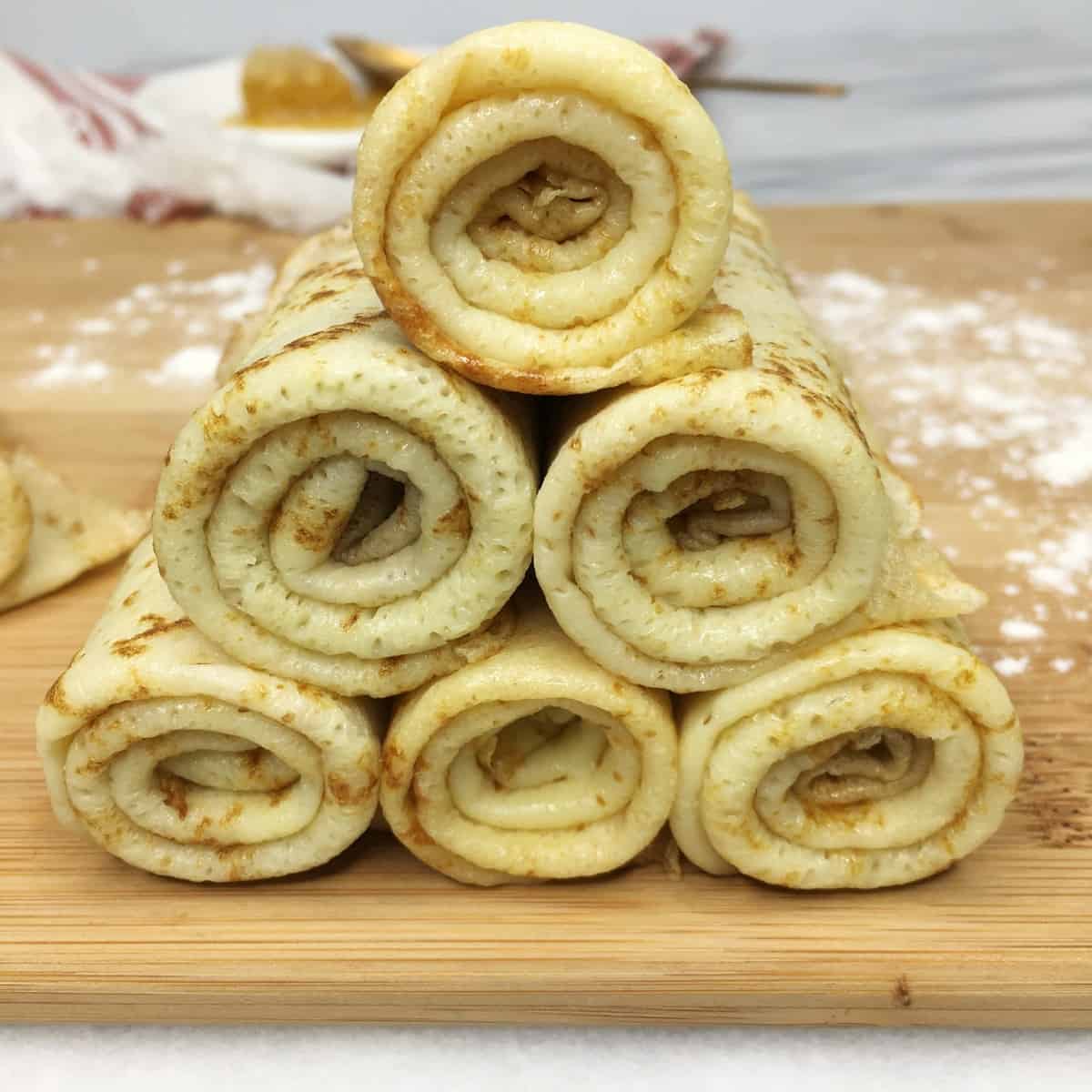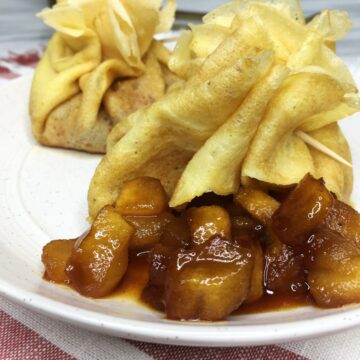The crepes ingredients list includes three simple ingredients: flour, eggs, and liquid (milk or water). The good news is that crepe lovers can rejoice because there are so many crepe variations to enjoy.

Crepes are an easy and versatile dish. You can make them with just three ingredients, or you could add in some flavorings to give your crepe an extra boost.
There is even room for creativity when it comes down to how many and what ingredients to use.
For the traditional crepe, the ingredients are limited to the 'flour + eggs + milk' mixture.
Gilles Isola
Who would have thought that using the number of ingredients in crepes, you can really break down recipes into different groups?
2-ingredient crepes are dairy-free and egg-free and are made with all-purpose flour and carbonated water, also known as, seltzer or soda water.
The 3-ingredient crepe recipe is simple too: it is made with three ingredients (flour, eggs, milk) plus oil or butter to grease a crepe pan.
Four-ingredient crepes are made with added sugar, salt, or vanilla extract as the fourth ingredient.
Five-ingredient crepes go further: their recipe includes oil or butter as a greasing agent.
Finally, the six-ingredient crepe recipe calls for the basic three ingredients, salt, sugar, and butter or oil.
What are the ingredients of a crepe? Well, it's all about that batter. One of the keys to making delicious and thin French crepes is figuring out just enough liquid.
But which liquid? How many eggs and much butter or oil should you add according to the recipe?
Let's have a look at all the crepe ingredients using the tips from Gilles Isola, the training manager at the Ecole Maître Crêpier & Cuisinier.
Jump to:
Flour
Flour is a key ingredient in making crepes. It provides proteins and starch, which are broken down to sugar for the Maillard reaction (aka browning reaction).
A classic French crepe recipe calls for plain flour (aka all-purpose flour), although buckwheat flour is another alternative, especially in Brittany, to make savory crêpes (galettes).
On the flour side, we opt for a pastry flour, T45 or T55, which is perfectly adapted.
Gilles Isola
Since the flour contains gluten, let the crepe batter rest for 30 minutes to absorb the liquid and give the gluten a chance to rest.
This step is considered the secret to making the perfect French crepes.
When it comes to gluten-free crepe making, many factors come into play: the type of flour, the measuring technique, the resting time for the batter, etc.
Some crepe recipes are made with chestnut flour that is sweeter and nuttier than the bitter flour version - buckwheat flour.
Also, read about how to make basic crepes.
Eggs
Fresh whole eggs are essential ingredients for crepes, although Julia Child uses yolks only. Eggs contribute to the structure, flavor, and color of crepes.
In our school, we recommend using between 8 and 10 eggs for a kilo of flour, which is quite a bit.
Gilles Isola
Some people like their crepes thin, and others prefer them thick, but it depends on how many eggs you use.
The less the number of eggs used for the crepe recipe means that your finished crepes will be delicate; the more eggs, the thicker crepes will result.
To make crepes soft and fluffy, you should try to separate the egg whites from the yolks.
Add the yolks at the beginning and incorporate whipped egg whites just before cooking. It makes the batter airy and light.
Find out if you need special equipment to make crepes.
Liquid
Liquid (milk or water) helps mix ingredients and aids in their dispersion, and contribute to some chemical reactions. It also contributes to the structure building of crepes.
Whole milk is the most popular choice to make French crepes, although low-fat and skim milk are also used to make the lighter version of crepes.
As for milk, there are about 2 liters per kilo of flour. For frying, I recommend a more liquid batter which will "roll" better and give a thinner crepe.
Gilles Isola
Can you replace milk with water in the crepe batter? Yes, the Polish pancakes recipe replaces part of the milk with sparkling or plain water.
Romanian cuisine uses half the milk and half water to make their thin and delicious crepes.
To experience honeycombed-looking crepes with a slight yeasty taste, you can replace 25% of the milk with beer. If you want to step out of the authenticity, use cider instead.
Finally, you can replace whole milk with milk alternatives such as almond milk, making almond milk crepes.
Should you warm up milk or use cold? Most crepe recipes call for ingredients at room temperature, but you can opt for cold milk.
In this case, the resting time for the crepe batter is essential. But, according to chef Philippe, if you boil milk and let it cool to a warm stage, you can skip the resting time.
You should end up with a smooth batter that resembles the consistency of heavy cream. It is evident that the less thick batter, the thinner the crepes.
But if your batter is too liquid, then it will be challenging to flip. So, it is all about a delicate balance between the too thick and thin batter.
Read about how to flip the crepe.
Salt
The use of salt is an ancient tradition that produces great flavor and improves the texture of crepes.
It slows down the gluten development, but it also produces a firmer batter and prolongs the shelf life of crepes.
Salt is an essential ingredient for making the most delicious crepes ever. For dessert crepes, don't skip it!
Sugar
Sugar brings sweetness and inhibits the gluten development and gelatinization of starch.
It contributes to the Maillard reaction, which gives that slightly golden brown color to crepes.
Granulated sugar is an optional ingredient in making crepes. Feel free to add a small amount of sugar if you make sweet crepes. However, omit this ingredient for savory crepes.
You can make crepes without sugar to serve with both sweet or savory fillings.
Also, read on how to store leftover crepes.
Fat
The fat works as a tenderizer, inhibiting gluten development and preventing starch gelatinization.
Adding melted butter to the crepe batter not only makes them tastier but also helps with cooking.
The pan doesn't need any greasing because enough butter will make it easy to peel off once the crepes are cooked.
In Brittany, butter is added to the preparation and it is always semi-salted: there are 20 g per kilo, it gives roundness in the mouth.
Gilles Isola
But you can try to replace butter with vegetable oil or olive oil to keep your crepes healthy. For 100 g butter, you should use 80 g oil. Some recipes recommend using clarified butter as a medium.
If you don't add butter or oil to the crepe batter, you should grease a non-stick crepe pan.
But how to grease the crepe pan or crepe maker? You can use a silicone brush or paper towel.
We grease the pan with paper towel; you can use butter or a drop of oil.
Gilles Isola
Discover if you can make the batter ahead of time.
Flavorings
There are various ways to flavor crepe batter. You can add all your favorite things, such as vanilla extract, orange flower water, or orange or lemon juice, before pouring it into the pan for a classic taste.
But there is also a boozy option to make your crepes even more delicious if you serve them to adults.
Try to experiment with adding dark rum, cognac, Cointreau, Grand Marnier, or Kirsch.
You should definitely try half dark rum or brandy plus half orange flower water for an interesting combination.
The batter can also be flavored with spices such as ground cinnamon and nutmeg.
Savory crepes are a great way to enjoy your favorite flavor profiles. Try adding spices like ground nutmeg and black pepper for an exciting twist on this traditional French dish.
Discover the sweet and savory options to serve crepes.
Order of ingredients
You might wonder if the order of ingredients matters. The answer is yes. You should not mix crepes ingredients anyhow.
To avoid lumps and obtain the homogeneous texture of the crepe batter, you should mix 50% of dry ingredients with 50% of wet ingredients.
According to the crepe expert Gilles Isola, "first pour the flour and a pinch of salt, then add the equivalent weight of liquid, that is to say, the eggs and the milk beaten together."
Then, she advises mixing the batter generously and adding "the rest of the milk and possibly the melted butter."
But what to do if the lumps form? The solution to getting rid of lumps in your crepe batter is as simple - pass the mixture through a fine-mesh sieve.
Learn how to make Nutella crepes with bananas.
Science behind crepes
Having crepes for breakfast seems nothing more than just whipping a crepe batter and cooking crepes.
Crepes are made with a few ingredients, but it is the mathematics that makes them so thin and light.
The science behind paper-thin crepes involves more than just chemical interactions.
There is also thickness involved for a given batter to be able to cook up into an appropriate size nonstick skillet.
This special calculator will help you determine how much of the crepes ingredients you need based on the number of crepes, their thickness, and the diameter of your pan.
FAQ
All-purpose flour contains from 8 to 11% gluten.
No, the crepes recipe doesn't contain any raising agent. It differs the French-style crepes from pancakes, for example, American pancakes.
To make a smooth and thin batter, you should mix 50% of dry ingredients with 50% of liquids. It means the flour should be combined with the liquid equivalently; then, the rest of the liquid should be added.
You should heat a crepe pan over medium to high heat, but use medium heat for cooking crepes.
Conclusion
This article teaches what ingredients go to make your favorite crepes and how each ingredient contributes to a crepe batter and finished crepes.
You can also learn about the order of ingredients to help create better-tasting crepes.
Crepe recipes
Crepe recipes are a delicious and perfect way to start your day. You can eat them for breakfast, appetizers, or dessert after dinner. Or enjoy them any time of the day!
The best crepes are your own crepes made from scratch. The recipes below will give you ideas for making those delicious crepes that everyone loves.











Comments
No Comments